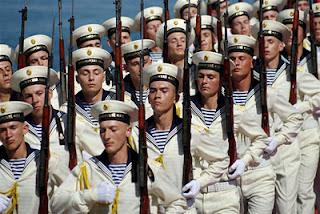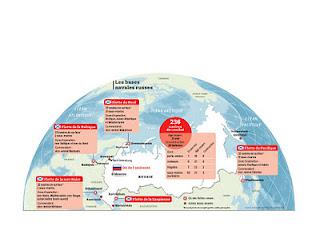 Ukraine’s recent decision to allow Russia to modernize its Black Sea Fleet raised once again the question about how long the Russian Navy will stay in Sevastopol. On April 21, 2010, Moscow and Kiev signed a deal extending the lease on the base for 25 years after the current lease expires in 2017.
Ukraine’s recent decision to allow Russia to modernize its Black Sea Fleet raised once again the question about how long the Russian Navy will stay in Sevastopol. On April 21, 2010, Moscow and Kiev signed a deal extending the lease on the base for 25 years after the current lease expires in 2017.
Nevertheless, ex-commander of the Russian Black Sea Fleet Admiral Igor Kasatonov said Russia will never give up its naval base in Ukraine’s port of Sevastopol on the Crimean peninsula. “The year 2042 is not the final date of the Black Sea Fleet’s presence in Crimea. The Russian Navy will stay in Sevastopol forever,” Kasatonov said in an interview with a Kiev-based Expert magazine. As explained by the admiral, naval base in Sevastopol played the utmost strategic role in the protection of Russia’s south-western border.
The Black Sea fleet has always been close to Russia’s heart and a priority in its foreign policy. The prospect of having to pack up and leave would mean having to quicken the pace in building the new base in Novorossiysk and expose in the meantime Russia’s south-western border, severely decreasing security not only in the Black Sea, but also in the Caucasus. Nevertheless, themainreason behind Russia’s interest in Crimea relies on the fact that the Black Sea fleet presence in Sevastopol blocks Ukraine’s accession to NATO, whose membership cannot be granted to a country housing a non-member’s military base in its territory.
The Sevastopol agreement therefore follows Russia’s 2010 Military Doctrine, which identifies the Atlantic Alliance as a serious threat to its sovereignty and to its presence in supposed Russian areas of influence. Thus, as a consequence of the last lease agreement, in principle Ukraine should not be able to join NATO at least until 2042. Ukraine is a critical region for Russia’s military strategic interests in Central Europe. After 1991, Russia has been thrown back to its seventeenth-century borders, with rather limited access to the Baltic and Black Seas. Keeping some form of “control” of Ukraine would give Russia access to Europe and create the superpower image that Russia has been striving for.
The Black Sea and Azov Sea ports in Odessa, Illichivsk, Nikolayev and Mariupol were very important economically during Soviet times. These ports provided more than 20 percent of export supplies to the Soviet Union. Trans-European gas pipelines “Bratstvo” and “Soyuz”, and the oil pipeline “Druzhba” run across Ukrainian territory. For Moscow, these facilities had significant importance as economic links with European states, and remain very important for Russia today. Ukraine has also a large-scale military infrastructure which serviced more than one million of the former Soviet troops. Some elements of this infrastructure are vital for Russia and Sevastopol is the most important of all.
Protecting Russian military-strategic interests in Eastern Europe without Ukraine would require Russian creation of a completely new military infrastructure, which is extremely costly and may not be adequate for Russia’s aspirations in the region. That is why Russia is very sensitive to the loss of Ukraine as a military-strategic area, and makes attempts to maintain its strategic presence in the Black Sea and the control of the port of Sevastopol as a key naval base for the Russian Black Sea Fleet.
RUSSIAN NAVAL BASES
 If following recent negotiations between Moscow and Kiev, the Russian Black Sea Fleet will be reinforced with 15 new combat ships and diesel-electric submarines by 2020, as already announced last year by Russian Navy Commander-in-Chief Admiral Vladimir Vysotsky, it could become a formidable force by 2035. And perhaps the spearhead of a Russian navy determined to regain the role it played during the Cold War.
If following recent negotiations between Moscow and Kiev, the Russian Black Sea Fleet will be reinforced with 15 new combat ships and diesel-electric submarines by 2020, as already announced last year by Russian Navy Commander-in-Chief Admiral Vladimir Vysotsky, it could become a formidable force by 2035. And perhaps the spearhead of a Russian navy determined to regain the role it played during the Cold War.

